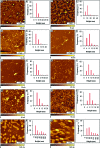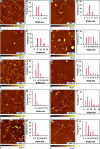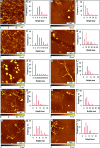Effects of peptides derived from terminal modifications of the aβ central hydrophobic core on aβ fibrillization
- PMID: 22778807
- PMCID: PMC3368634
- DOI: 10.1021/cn900019r
Effects of peptides derived from terminal modifications of the aβ central hydrophobic core on aβ fibrillization
Abstract
Considerable research effort has focused on the discovery of mitigators that block the toxicity of the β-amyloid peptide (Aβ) by targeting a specific step involved in Aβ fibrillogenesis and subsequent aggregation. Given that aggregation intermediates are hypothesized to be responsible for Aβ toxicity, such compounds could likely prevent or mitigate aggregation, or alternatively cause further association of toxic oligomers into larger nontoxic aggregates. Herein we investigate the effect of modifications of the KLVFF hydrophobic core of Aβ by replacing N- and C-terminal groups with various polar moieties. Several of these terminal modifications were found to disrupt the formation of amyloid fibrils and in some cases induced the disassembly of preformed fibrils. Significantly, mitigators that incorporate MiniPEG polar groups were found to be effective against Aβ(1-40) fibrilligonesis. Previously, we have shown that mitigators incorporating alpha,alpha-disubstituted amino acids (ααAAs) were effective in disrupting fibril formation as well as inducing fibril disassembly. In this work, we further disclose that the number of polar residues (six) and ααAAs (three) in the original mitigator can be reduced without dramatically changing the ability to disrupt Aβ(1-40) fibrillization in vitro.
Keywords: Amyloid peptide (Aβ); assembly; disassembly; fibrils; mitigators; spherical structures.
Figures









Similar articles
-
Structure-activity relationships in peptide modulators of β-amyloid protein aggregation: variation in α,α-disubstitution results in altered aggregate size and morphology.ACS Chem Neurosci. 2010 Sep 15;1(9):608-26. doi: 10.1021/cn100045q. Epub 2010 Jul 8. ACS Chem Neurosci. 2010. PMID: 22778850 Free PMC article.
-
Substoichiometric inhibition of Abeta(1-40) aggregation by a tandem Abeta(40-1-Gly8-1-40) peptide.Biochem Biophys Res Commun. 2010 Jul 2;397(3):509-12. doi: 10.1016/j.bbrc.2010.05.144. Epub 2010 May 31. Biochem Biophys Res Commun. 2010. PMID: 20515649 Free PMC article.
-
Aggregation and fibril morphology of the Arctic mutation of Alzheimer's Aβ peptide by CD, TEM, STEM and in situ AFM.J Struct Biol. 2012 Oct;180(1):174-89. doi: 10.1016/j.jsb.2012.06.010. Epub 2012 Jun 28. J Struct Biol. 2012. PMID: 22750418 Free PMC article.
-
Modulation of Amyloid β-Protein (Aβ) Assembly by Homologous C-Terminal Fragments as a Strategy for Inhibiting Aβ Toxicity.ACS Chem Neurosci. 2016 Jul 20;7(7):845-56. doi: 10.1021/acschemneuro.6b00154. Epub 2016 Jul 5. ACS Chem Neurosci. 2016. PMID: 27322435 Free PMC article. Review.
-
Dye-binding assays for evaluation of the effects of small molecule inhibitors on amyloid (aβ) self-assembly.ACS Chem Neurosci. 2012 Nov 21;3(11):807-19. doi: 10.1021/cn300076x. Epub 2012 Aug 6. ACS Chem Neurosci. 2012. PMID: 23173064 Free PMC article. Review.
Cited by
-
Short Peptides as Inhibitors of Amyloid Aggregation.Open Biotechnol J. 2011 Dec 23;5:39-46. doi: 10.2174/1874070701105010039. Open Biotechnol J. 2011. PMID: 24653784 Free PMC article.
-
Molecular mechanisms of amyloid disaggregation.J Adv Res. 2021 May 20;36:113-132. doi: 10.1016/j.jare.2021.05.007. eCollection 2022 Feb. J Adv Res. 2021. PMID: 35127169 Free PMC article. Review.
-
Aβ and Tau Interact with Metal Ions, Lipid Membranes and Peptide-Based Amyloid Inhibitors: Are These Common Features Relevant in Alzheimer's Disease?Molecules. 2022 Aug 9;27(16):5066. doi: 10.3390/molecules27165066. Molecules. 2022. PMID: 36014310 Free PMC article. Review.
-
Fibril Core of Transforming Growth Factor Beta-Induced Protein (TGFBIp) Facilitates Aggregation of Corneal TGFBIp.Biochemistry. 2015 May 19;54(19):2943-56. doi: 10.1021/acs.biochem.5b00292. Epub 2015 May 6. Biochemistry. 2015. PMID: 25910219 Free PMC article.
-
Molecular Mechanisms of Inhibition of Protein Amyloid Fibril Formation: Evidence and Perspectives Based on Kinetic Models.Int J Mol Sci. 2022 Nov 3;23(21):13428. doi: 10.3390/ijms232113428. Int J Mol Sci. 2022. PMID: 36362217 Free PMC article. Review.
References
-
- Selkoe D. J. (1991) The molecular pathology of Alzheimers-disease. Neuron 6, 487–498. - PubMed
-
- Selkoe D. J. (2003) Folding proteins in fatal ways. Nature 426, 900–904. - PubMed
-
- Tycko R. (2003) Insights into the amyloid folding problem from solid-state NMR. Biochemistry 42, 3151–3159. - PubMed
-
- Chromy B. A.; Nowak R. J.; Lambert M. P.; Viola K. L.; Chang L.; Velasco P. T.; Jones B. W.; Fernandez S. J.; Lacor P. N.; Horowitz P.; Finch C. E.; Krafft G. A.; Klein W. L. (2003) Self-assembly of A beta(1−42) into globular neurotoxins. Biochemistry 42, 12749–12760. - PubMed
MeSH terms
Substances
LinkOut - more resources
Full Text Sources

